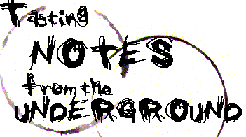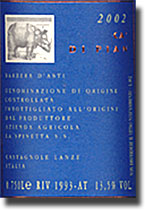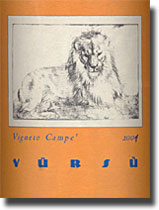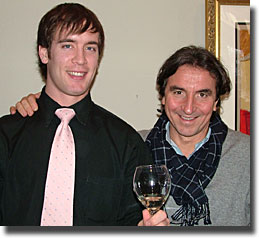|
|
 |
|
|
|
a 
In 1977, Giorgio's father, Giuseppe Rivetti (nicknamed Pin) and his family bought the La Spinetta (top of the hill) estate in Castagnole Lanze. They then began to purchase choice parcels of vineyard property, making their first red, the Barbera C à di Pian in 1985. 1989 brought about the first Pin, a blend of Barbera and Nebbiolo, followed by their first Barbaresco Gallina in 1995 and their first Barolo Campè in 2000. In 2001, La Spinetta acquired 65 hectares of vineyards in Tuscany to make three different 100% Sangiovese wines, and so the Rivetti horizon continues to expand.Giorgio and his brothers Carlo and Bruno strive to make great red wines that you can enjoy early, and yet age for 20 - 25 years. By limiting yields, using little or no chemicals or pesticides (75% of the vineyards are farmed bio-dynamically) and employing state of the art technology, La Spinetta has moved into the forefront of producers in Piemonte. We got the afternoon started with a splash of Chardonnay. 2002 La Spinetta Piemonte Chardonnay Lidia DOC, $38.99, 13.5% alc.: Medium straw with a tinge of lime in color; toasty oak in good proportion to the nice apple and pear flavors and aromas. Medium bodied and relatively light compared to white Burgundy or Left Coast US Chardonnay, but clean, crisp and straightforward. From vines averaging 15 years old; undergoes alcoholic and malolactic fermentation during 12 months in new French oak, then spends another 6 - 8 months in stainless steel vats before bottling.  2002 La Spinetta Barbera d'Asti Cà
di Pian DOC, $26.99, 13.5% alc.:
Dark garnet color, with sweet oak and chocolate dominating the plum and
black cherry nose, and following through on the palate with more fruit
and less oak. Quite dry, and moderately tannic, on a medium - full to
full bodied - frame, with a good finish. From 6 - 20 year old vines;
alcoholic fermentation for 6 - 7 days in rotofermenters at controlled
temperature, malolactic fermentation in medium toast new French oak for
12 months, followed by 6 months in stainless steel vats before bottling
and 2 months further aging; unfiltered, unfined. Very nice with
Bacco's delicious Carpaccio plate. 2002 La Spinetta Barbera d'Asti Cà
di Pian DOC, $26.99, 13.5% alc.:
Dark garnet color, with sweet oak and chocolate dominating the plum and
black cherry nose, and following through on the palate with more fruit
and less oak. Quite dry, and moderately tannic, on a medium - full to
full bodied - frame, with a good finish. From 6 - 20 year old vines;
alcoholic fermentation for 6 - 7 days in rotofermenters at controlled
temperature, malolactic fermentation in medium toast new French oak for
12 months, followed by 6 months in stainless steel vats before bottling
and 2 months further aging; unfiltered, unfined. Very nice with
Bacco's delicious Carpaccio plate. 2003 La Spinetta Barbera d'Alba Gallina DOC, $55.99, 14.5% alc.: Deep, saturated dark garnet in color, fading to pink at the rim; again, toasty oak and chocolate dominate the nose, showing more on the palate than with the Cà di Pian. Very concentrated, with dry black currant, black plum and dried cherry flavors, a smooth creamy mouth feel, non - aggressive tannins and a long finish. From vines averaging 30 years old; alcoholic fermentation for 6 - 7 days in rotofermenters at controlled temperature, malolactic fermentation in medium toast new French oak for 16 - 18 months, followed by 6 months in stainless steel vats before bottling and 3 months further aging; unfiltered, unfined. 2001 La Spinetta Barbera d'Asti Superiore DOC, $55.99, 14.5% alc.: Saturated purple garnet in color, fading to pink at the rim, with sweet oak and chocolate on the nose, following through some on the palate while allowing the deep, dry black currant fruit to shine through with fine tannins, zippy acidity and a long finish. One taster remarked that "there's so much fruit, the acid is no problem." From vines averaging 45 - 55 years old; alcoholic fermentation for 6 - 7 days in rotofermenters at controlled temperature, malolactic fermentation in medium toast new French oak for 16 - 18 months, followed by 6 months in stainless steel vats before bottling and 3 months further aging; unfiltered, unfined. This wine matches very nicely with the Strozzapreti Norcina (Palamino sauce with Italian sausage, black truffles and wine).  Someone questioned the significance of the term "Superiore," and Giorgio
informed us that it is a special DOC classification for old vine, low
production vineyards; the wines also need to age 2 years before release.
He also told us that the future of Barbera is in Asti, rather than
Alba.
"Too little Barbera is produced in Alba," he stated, "where Nebbiolo
rules. In Asti, Barbera rules." Someone questioned the significance of the term "Superiore," and Giorgio
informed us that it is a special DOC classification for old vine, low
production vineyards; the wines also need to age 2 years before release.
He also told us that the future of Barbera is in Asti, rather than
Alba.
"Too little Barbera is produced in Alba," he stated, "where Nebbiolo
rules. In Asti, Barbera rules."2001 La Spinetta Monferrato Rosso Pin DOC, 65% Nebbiolo, 35% Barbera, $52.99, 14.5% alc.: Named in honor if Giuseppe Rivetti; Giorgio says that while the Nebbiolo dominates the flavors, the Barbera dominates the color, a deep dark garnet fading to pink at the rim. Like the others, it shows sweet oak and chocolate over black fruit in flavor and aroma, being a little fatter than the straight Barberas, with excellent structure and a long finish. New world in character, with a great future. Separate alcoholic fermentation for each varietal 7 - 8 days in rotofermenters at controlled temperature, malolactic fermentation in medium toast new French oak for 16 - 18 months, followed by blending and 2 months in stainless steel vats before bottling and 3 months further aging; unfiltered, unfined. 2001 La Spinetta Barbaresco Starderi DOC, $128.99, 14.5% alc.: Giorgio described Starderi as one of the best vineyards in Barbaresco; ruby garnet with a tinge of smoke, showing less chocolate on the nose, and more floral character, including rose petal, black cherry, raspberry and strawberry. Flavors echo beautifully, with underbrush and earth in the background; opulent, sexy, ravishing, with tannins that show mostly on the finish. From vines averaging 35 - 45 years old; alcoholic fermentation for 7 - 8 days in rotofermenters at controlled temperature, malolactic fermentation in medium toast new French oak for 20 - 22 months, followed by 3 months in stainless steel vats before bottling and 12 months further aging; unfiltered, unfined. Giorgio Rivetti 2001 La Spinetta Barbaresco Valeirano DOC, $128.99,14.5% alc.: Ruby garnet, with restrained sweet oak, chocolate and a hint of aquarium over black fruit on the nose and in the mouth; lovely, silky, creamy smooth, and deceptively so, considering the ample structure. From vines averaging 35 - 45 years old; alcoholic fermentation for 7 - 8 days in rotofermenters at controlled temperature, malolactic fermentation in medium toast new French oak for 20 - 22 months, followed by 3 months in stainless steel vats before bottling and 12 months further aging; unfiltered, unfined. Terrific with the Lombata di Vitello all Pepe Verde (Prime veal chop marinated, char grilled and served with a green peppercorn, truffle and sage demi glace). The following two were presented to contrast with the '01s, the first to show what was produced in a relatively poor vintage, and the second to give some evidence of what they can do with a little age. 2002 La Spinetta Barbaresco DOC, $95: La Spinetta produced no cru Barbaresco from this "off vintage;" everything went into this wine. Ruby dark garnet, fading to pink at the rim, with a sleeker sweet oak and chocolate bouquet than the '01s and showing floral undertones as well, it doesn't smell as "fat' as the previous vintage. Lovely flavors of dried cherry, with a note of chocolate in support and hints of earth and underbrush in the background. Smooth in texture, with deceptive structure to take it well down the road.
Giorgio Rivetti 1999 La Spinetta Barbaresco Valeirano DOC, $125: Chris Brandt from Cloverleaf Fine Wines described this ruby dark garnet as "smoother than Mel Tormé, like the finest down pillow." Rich black cherry and chocolate grace the nose, with a little aquarium and subtle notes of earth and underbrush in the background, all of which follow through on the palate. So rich, ripe and opulent on the palate, with hints of cedar emerging as it opens; silky, elegant, absolutely marvelous, and what a future! One would be hard pressed to leave this in the cellar; it was certainly my Wine of the Day.  2000 La Spinetta Barolo Campè DOCG, $140, 14.5% alc.: Ruby garnet,
fading to pink at the rim, with a sweet oak and chocolate bouquet
showing floral overtones; on the palate, there's chocolate in good
proportion to the black cherry and dried cherry flavors. Poured towards
the end of the luncheon, so time was short, and it was hard to get more
than the briefest snapshot, but again, it showed a smooth, opulent
texture and deceptive structure that will allow it to age for many
years. I'd have liked to have spent more time with this one. From vines
averaging 35 - 45 years old; alcoholic fermentation for 7 - 8 days in rotofermenters at controlled temperature, malolactic fermentation in
medium toast new French oak for 20 - 22 months, followed by 9 months in
stainless steel vats before bottling and 12 months further aging;
unfiltered, unfined. 2000 La Spinetta Barolo Campè DOCG, $140, 14.5% alc.: Ruby garnet,
fading to pink at the rim, with a sweet oak and chocolate bouquet
showing floral overtones; on the palate, there's chocolate in good
proportion to the black cherry and dried cherry flavors. Poured towards
the end of the luncheon, so time was short, and it was hard to get more
than the briefest snapshot, but again, it showed a smooth, opulent
texture and deceptive structure that will allow it to age for many
years. I'd have liked to have spent more time with this one. From vines
averaging 35 - 45 years old; alcoholic fermentation for 7 - 8 days in rotofermenters at controlled temperature, malolactic fermentation in
medium toast new French oak for 20 - 22 months, followed by 9 months in
stainless steel vats before bottling and 12 months further aging;
unfiltered, unfined. One dominant characteristic is consistent throughout most of the reds, that being the new oak and chocolate overtones; purists may not care for them, but I have no problem with them at all. What I would like to know is how these wines taste with some age; the '99 La Spinetta Barbaresco Valeirano gives but a tantalizing hint of what the future holds for that wine. 2003 La Spinetta Moscato d'Asti Biancospino DOCG, 5.5% alc.: Pale, pale straw, with a lazy effervescence in the glass, but an ebullient froth in the mouth; Chris Brandt described a "wet fruit salad nose," and I can't argue with that. If you've had fresh moscato grapes to eat, you know pretty much what this tastes like, just add frizzante and a little more concentrated sugar level. Delightfully refreshing; wipes the slate clean on the palate. Giorgio Rivetti is affable and gregarious, and if passionate seems more and more a cliché‚ used to describe the modern winemaker, it certainly does fit him well. It was a great pleasure to sit across the table from him and hear what he had to say about his wines and estate. And of course, it's always a treat to enjoy the marvelous Italian cuisine once again at Bacco Ristorante. Many thanks to Giorgio, Elite Brands' Gerry Hammerschmidt and R.J. Tibus and Bacco's Luciano del Signore.  Reporting from Day-twah, Reporting from Day-twah,
Bastardo |
|||
|
Other Recent Wine Explorations
Back to the
Underground
Index
|
|||


